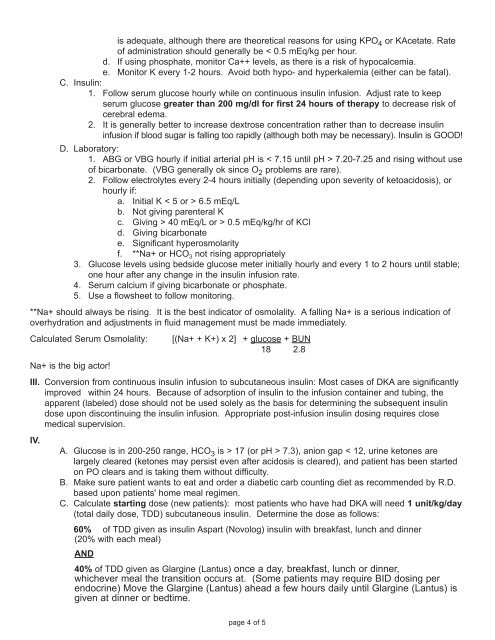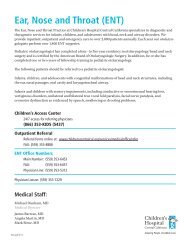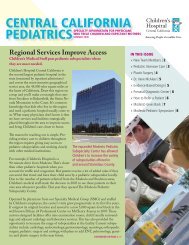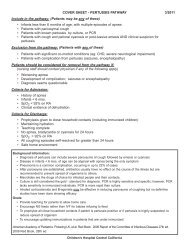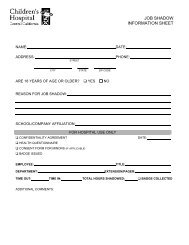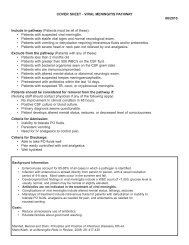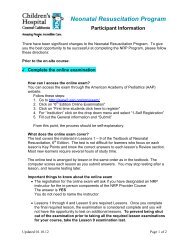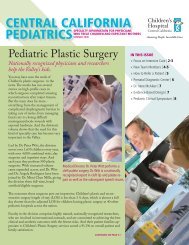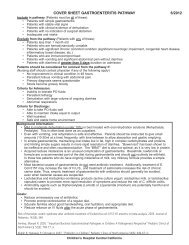Diabetic Ketoacidosis Pathway - Children's Hospital Central California
Diabetic Ketoacidosis Pathway - Children's Hospital Central California
Diabetic Ketoacidosis Pathway - Children's Hospital Central California
- No tags were found...
You also want an ePaper? Increase the reach of your titles
YUMPU automatically turns print PDFs into web optimized ePapers that Google loves.
is adequate, although there are theoretical reasons for using KPO 4 or KAcetate. Rateof administration should generally be < 0.5 mEq/kg per hour.d. If using phosphate, monitor Ca++ levels, as there is a risk of hypocalcemia.e. Monitor K every 1-2 hours. Avoid both hypo- and hyperkalemia (either can be fatal).C. Insulin:1. Follow serum glucose hourly while on continuous insulin infusion. Adjust rate to keepserum glucose greater than 200 mg/dl for first 24 hours of therapy to decrease risk ofcerebral edema.2. It is generally better to increase dextrose concentration rather than to decrease insulininfusion if blood sugar is falling too rapidly (although both may be necessary). Insulin is GOOD!D. Laboratory:1. ABG or VBG hourly if initial arterial pH is < 7.15 until pH > 7.20-7.25 and rising without useof bicarbonate. (VBG generally ok since O 2 problems are rare).2. Follow electrolytes every 2-4 hours initially (depending upon severity of ketoacidosis), orhourly if:a. Initial K < 5 or > 6.5 mEq/Lb. Not giving parenteral Kc. Giving > 40 mEq/L or > 0.5 mEq/kg/hr of KCld. Giving bicarbonatee. Significant hyperosmolarityf. **Na+ or HCO 3 not rising appropriately3. Glucose levels using bedside glucose meter initially hourly and every 1 to 2 hours until stable;one hour after any change in the insulin infusion rate.4. Serum calcium if giving bicarbonate or phosphate.5. Use a flowsheet to follow monitoring.**Na+ should always be rising. It is the best indicator of osmolality. A falling Na+ is a serious indication ofoverhydration and adjustments in fluid management must be made immediately.Calculated Serum Osmolality:[(Na+ + K+) x 2] + glucose + BUN18 2.8Na+ is the big actor!III. Conversion from continuous insulin infusion to subcutaneous insulin: Most cases of DKA are significantlyimproved within 24 hours. Because of adsorption of insulin to the infusion container and tubing, theapparent (labeled) dose should not be used solely as the basis for determining the subsequent insulindose upon discontinuing the insulin infusion. Appropriate post-infusion insulin dosing requires closemedical supervision.IV.A. Glucose is in 200-250 range, HCO 3 is > 17 (or pH > 7.3), anion gap < 12, urine ketones arelargely cleared (ketones may persist even after acidosis is cleared), and patient has been startedon PO clears and is taking them without difficulty.B. Make sure patient wants to eat and order a diabetic carb counting diet as recommended by R.D.based upon patients' home meal regimen.C. Calculate starting dose (new patients): most patients who have had DKA will need 1 unit/kg/day(total daily dose, TDD) subcutaneous insulin. Determine the dose as follows:60% of TDD given as insulin Aspart (Novolog) insulin with breakfast, lunch and dinner(20% with each meal)AND40% of TDD given as Glargine (Lantus) once a day, breakfast, lunch or dinner,whichever meal the transition occurs at. (Some patients may require BID dosing perendocrine) Move the Glargine (Lantus) ahead a few hours daily until Glargine (Lantus) isgiven at dinner or bedtime.page 4 of 5


